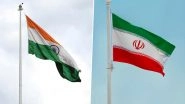New Delhi, July 22: On July 22, 1947, the tricolour flag or Tiranga comprising colours saffron, white and green with the Ashok Chakra was adopted as the National Flag of India. Hence, the National Flag Adoption Day is observed on July 22 every year. On this National Flag Adoption Day, we will tell you what each colour of the tricolour flag means. The design of the Indian national flag is inspired by Congress's flag, which was designed by Pingali Venkayya.
India became an independent counrty on August 15, 1947. The Constituent Assembly on July 22 adopted Tiranga as the national flag of the country and since then July 22 is celebrated as the "National Flag Adoption Day". In 1921, Mahatma Gandhi suggested the Indian National Congress have its own flag. Pingali Venkayya was told to design a flag with a spinning wheel on colour Red (for Hindus) and colour Green (for Muslims) on it. National Flag Adoption Day 2019: Significance and History of the Tricolour or Tiranga, India's National Flag.
The spinning wheel symbolises self-reliance. Later, a white stripe was included in the centre for other religious communities. In 1929, Mahatma Gandhi stated that red stood for the sacrifices of the people, white for purity, and green for hope to avoid religious and sectarian divide.
After India gained independence, first Prime Minister Jawaharlal Nehru proposed before the Constituent Assembly the horizontal tricolour with colour saffron, white and green on the flag in equal proportion and Ashoka Chakra (wheel) in blue printed on the white space in between. The Constituent Assembly, headed by Dr Rajendra Prasad, unanimously passed the resolution in favour of the tricolour flag. On January 26, 1950, Tiranga became the flag of the Republic of India.
Explaining the significance of colours and Ashoka Chakra in Tiranga, Philosopher Sarvepalli Radhakrishnan, who later became India's first Vice President and second President: "Bhagwa or the Saffron denotes renunciation or disinterestedness. Our leaders must be indifferent to material gains and dedicate themselves to their work. The white in the centre is light, the path of truth to guide our conduct. The green shows our relation to (the) soil, our relation to the plant life here, on which all other life depends."
"The Ashoka Chakra in the centre of the white is the wheel of the law of dharma. Truth or satya, dharma or virtue ought to be the controlling principle of those who work under this flag. Again, the wheel denotes motion. There is death in stagnation. There is life in movement. India should no more resist change, it must move and go forward. The wheel represents the dynamism of a peaceful change," he added.
(The above story first appeared on LatestLY on Jul 22, 2019 09:21 AM IST. For more news and updates on politics, world, sports, entertainment and lifestyle, log on to our website latestly.com).













 Quickly
Quickly


